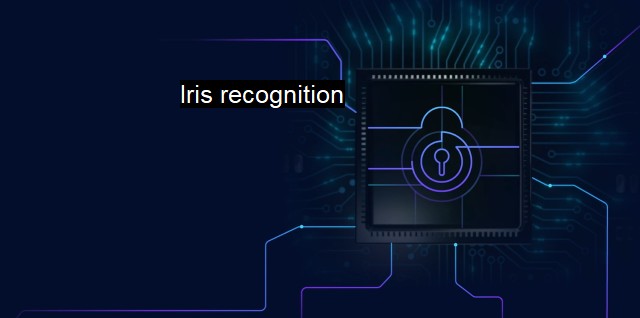What is Iris recognition?
Iris Recognition: Strengthening Cybersecurity Measures in Today’s Digital Age
Iris recognition is an automated method of biometric identification that uses mathematical pattern-recognition techniques on video images of the irises of an individual's eyes. this technology has immense applications as a powerful tool for user identification and authentication, acting in many ways like an advanced password or key.The unique and complex pattern of an individual's iris formed during fetal gestation is incredibly stable and remains unchanged throughout one's lifespan. As a result, iris patterns are among the most reliable biometric identifiers, proving highly accurate. In terms of false positives, iris recognition often shows a near-zero percentage, making it perfect for high-security implementations.
The iris recognition process starts with capturing an image of the eye. This digital image acquisition can be collected in various illumination conditions and doesn't require physical contact, thus providing a non-intrusive experience to users. Quality assessment techniques are then used to check if the recorded iris images are of sufficient quality for accurate recognition.
The next step in iris recognition is segmentation and normalization of the iris image. Segmentation discerns the outer and inner boundaries of the iris, isolating it from the pupil, eyelids, eyelashes, and ocular reflections. After segmenting the iris region, normalization involves transforming the iris region to a certain size to ensure a constant dimension, making iris recognition more reliable.
Feature extraction is then performed— identifying the most discernable and unique details in the iris pattern. The biometric template generated from the complex iris pattern is usually small in size, making storage and speedy verification viable without significant technological investment.
For identification and verification, this captured iris pattern is then compared against a database of pre-recorded iris patterns. The technology uses advanced matching and machine learning algorithms to compare a given iris pattern with existing ones. In authentication systems, a correctly recognized iris allows entrance, access, or kickstarts an action, depending on the system's design.
In today's cybersecurity context, where password breaches and duplication incidents are increasingly common, iris recognition technology offers an impressive solution— replacing or reinforcing traditional password systems with something much harder to replicate: the human iris.
Further, in the context of antivirus technologies, iris recognition might enhance security protocols, integrating biometric identification into its defensive strategy. For instance, identity-based scams and malware attacks often rely on exploiting user vulnerabilities, such as weak passwords or insecure practices. No two irises are alike, even those of identical twins, making them difficult to mimic. Consequently, iris recognition reduces the possibility of identity theft, supplementing antivirus measures.
Iris recognition technology comes with its own set of challenges. For robust public usage, it's vital to ensure the technology is compatible with an array of devices, secure against hacking attempts, and foolproof against artificial iris copies. Equipment costs, wide-scale database management, privacy concerns, and user comfort are additional parameters to consider.
With the advancement of camera technology, data processing power, and artificial intelligence, concerns like high implementation cost and limited integration into existing technology are becoming addressable. Iris recognition, despite a few concerns, has a strong footing due to its high reliability, contactless mode of operation, and robust anti-spoofing properties.
Cybersecurity is an ever-evolving domain, and iris recognition offers a promising, user-friendly, and virtually impossible to fool authentication solution. As millions of cyber threats target our devices daily and digital privacy continues to lose ground, iris recognition could be used in antivirus software and online platforms to ensure the person interacting is authenticated and make security measures more impenetrable. If integrated effectively, iris recognition technology could be the key to a more secure future, replacing, or at least heavily supplementing, the common password-based systems used today.

Iris recognition FAQs
What is iris recognition and how does it work in cybersecurity and antivirus?
Iris recognition is a biometric technology that identifies individuals based on the unique patterns in their irises (colored portion of the eye). It works in cybersecurity and antivirus by providing an additional layer of security for accessing sensitive data and preventing unauthorized access.How secure is iris recognition compared to other biometric technologies?
Iris recognition is considered one of the most secure biometric technologies available. The unique patterns in the iris are highly complex and difficult to replicate, making it very difficult for fraudsters to bypass.Can iris recognition be fooled by fake or altered irises?
Iris recognition technology has advanced significantly and can detect and prevent most attempts to fool it. However, in rare cases, it may be possible to fool iris recognition by using high-quality fake or altered irises.Is iris recognition technology widely available and in use?
Iris recognition technology is increasingly being used in various industries and applications, including cybersecurity and antivirus. However, it is still relatively expensive and complex compared to other biometric technologies, so it may not be widely available or implemented in all organizations.| | A | | | B | | | C | | | D | | | E | | | F | | | G | | | H | | | I | | | J | | | K | | | L | | | M | |
| | N | | | O | | | P | | | Q | | | R | | | S | | | T | | | U | | | V | | | W | | | X | | | Y | | | Z | |
| | 1 | | | 2 | | | 3 | | | 4 | | | 7 | | | 8 | | |||||||